
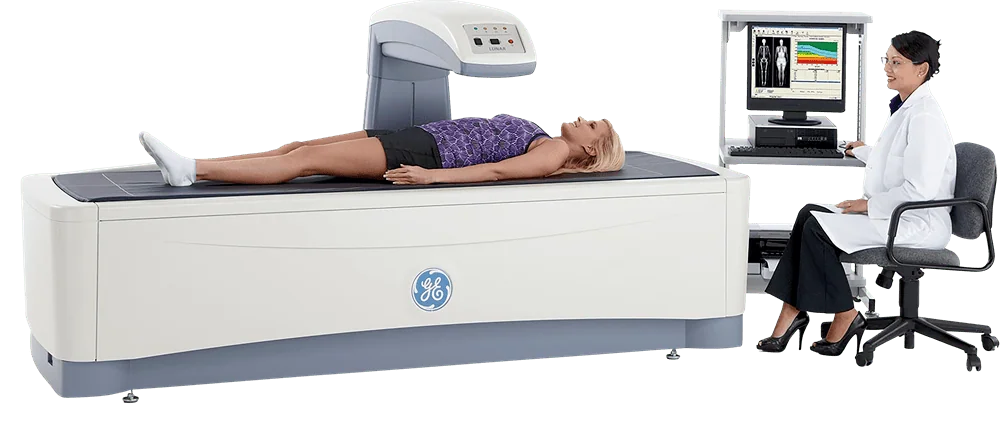
DEXA Speaks Louder than Scales
Sure, your weight might be changing. But is it fat, muscle, or bone? The Apex Fit DEXA scan is the most trusted method you can use to find out.
GET ANSWERS NOT ESTIMATES
A DEXA scan is the Golf Standard and most accurate device to measure body composition and bone mineral density. It provides a clearer understanding of your body composition and skeletal health.
- Map and pinpoint your precise muscle gains and fat loss in specific areas of the body
- Track your body’s specific physiological response to your diet or fitness plan
- Discover your bone health and risk for osteoporosis
- Identify personal long-term health risks, including diabetes, cardiovascular disease, hormonal imbalances, and more
Book Consultation
WHAT IS A DEXA SCAN?
The Dexa (DXA) Scan is an FDA approved procedure that gives you a closer look at your body than you have ever had before. It offers you an advantage in meeting and surpassing your health and weight loss goals while also returning data on how you’re doing on the inside. The DXA in Dexa Scan stands for Dual Energy X-Ray Absorptiometry. This means that the scan uses two (dual) X-ray beams to scan your body in a thorough yet noninvasive way. Due to this, we can guarantee that the exposure to radiation is low.
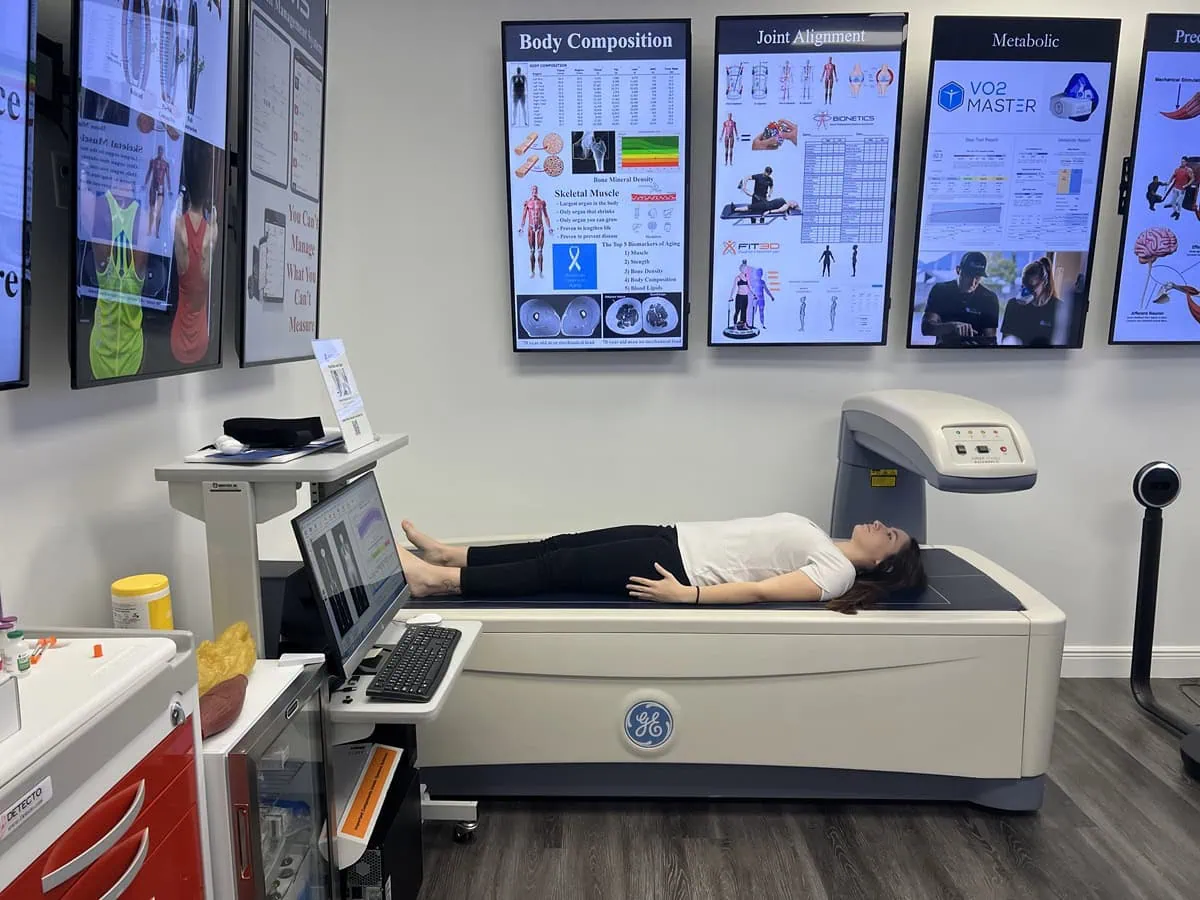
The Dexa Scan is designed and used to identify any and all problems, diseases, and conditions in the body. By looking at bone mass, bone mineral density, and body composition, the scan can check for certain diseases like liver disease, rheumatoid arthritis, and osteoporosis before they actually occur.
The scan looks for internal warning signs of these diseases that might not show themselves until after its too late, giving you a useful advantage in reclaiming your health before problems develop.
In addition to looking for these diseases, the Dexa Scan can also find weak points in your body and other risk factors. These weak points include areas where muscle mass is thinning, if there is any bone loss, or where fractures are more likely to happen. With this knowledge, you can give special attention to these areas to strengthen them to lower the fracture risks or chance of breaking a bone.
Finally, the Dexa Scan also measures your body composition. This includes the amount of body fat you carry as well as how and where it is carried in the body.
The Dexa Scan returns measurement data on deep belly fat, also known as visceral fat, and can be used to help identify and diagnose certain diseases and health problems like cardiovascular disease, breast cancer, and type-2 diabetes.
The scan is so thorough that it will be able to find excess fat between organs, identify problem areas, and determine issues like high cholesterol and metabolic disturbances. With the Dexa Scan, you are really getting a behind-the-scenes look at your body, giving you the knowledge and control you need to prevent health issues, lose weight, and improve your overall fitness.
Dexa For Body Composition
DEXA MEASURES LEAN MASS, SUBCUTANEOUS FAT & VISCERAL FAT BETTER THAN ANY OTHER MACHINE ON EARTH
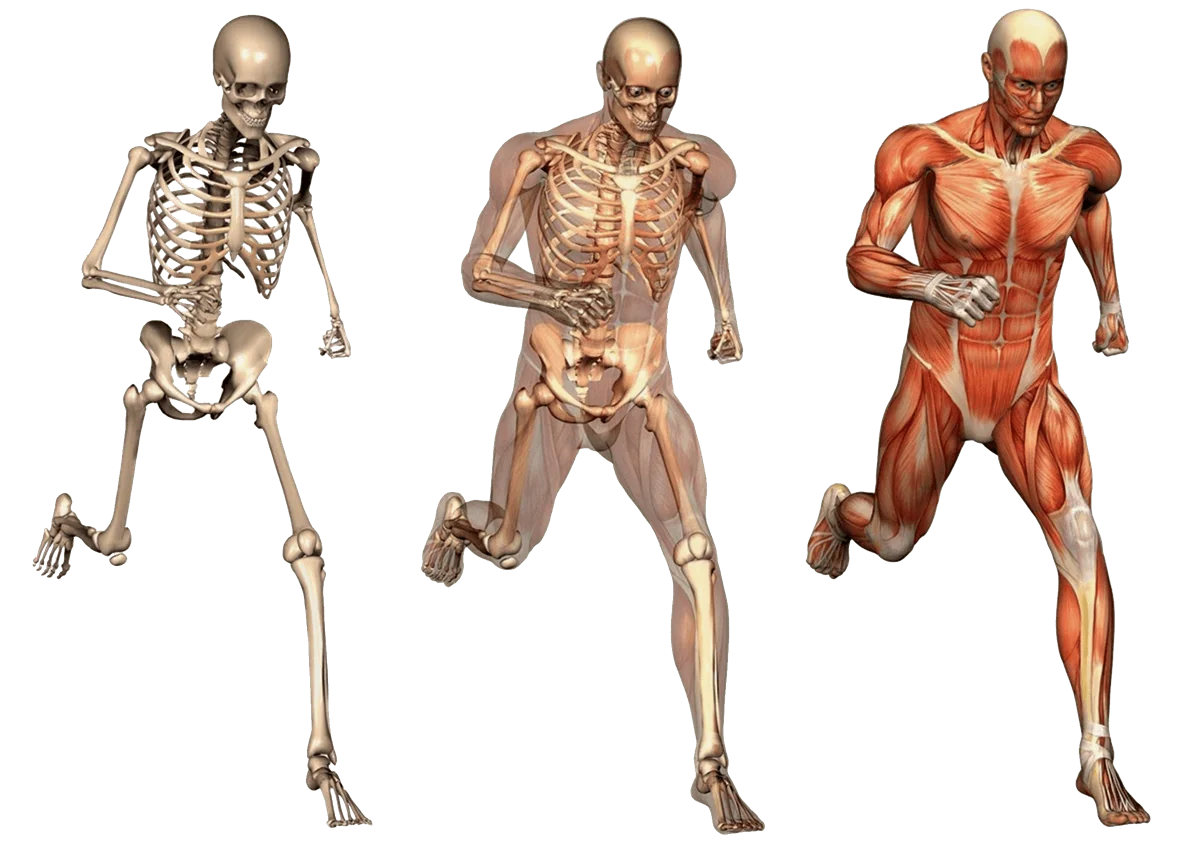
LEAN MASS
Lean mass, composed primarily of muscles, bones, and organs, plays a pivotal role in the overall health and functionality of the body. The DEXA scan can show to a gram the increased in skeletal muscle gains or losses as any increase of decrease in total lean mass is primarily a function of skeletal muscle and bone and organ mass remains constant.
Skeletal muscle is the largest organ in the body. It is arguably the most important substance you have underneath your skin. It’s direct effects on the endocrine system are so significant that the National Institute of Health has now classified skeletal muscle as an endocrine organ. Skeletal muscle is the only organ in the body that significantly decreases you age, and it is the only organ in the body that you can grow.
What lead to the classification of skeletal muscle being an organ was the discovery of myokines, proteins with anti-inflammatory and anti-aging properties, that get release when muscles contract. The more muscle tissue you have to contract the more myokines can be released throughout your body.
There are numerous studies that show a direct correlation with lean muscle mass and longevity to life. Lean mass supports mobility, balance, and structural integrity, reducing the risk of injuries and enhancing physical performance in various activities, from daily tasks to athletic endeavors. Additionally, lean mass is associated with improved insulin sensitivity and glucose metabolism, lowering the risk of chronic diseases like type 2 diabetes and cardiovascular disorders
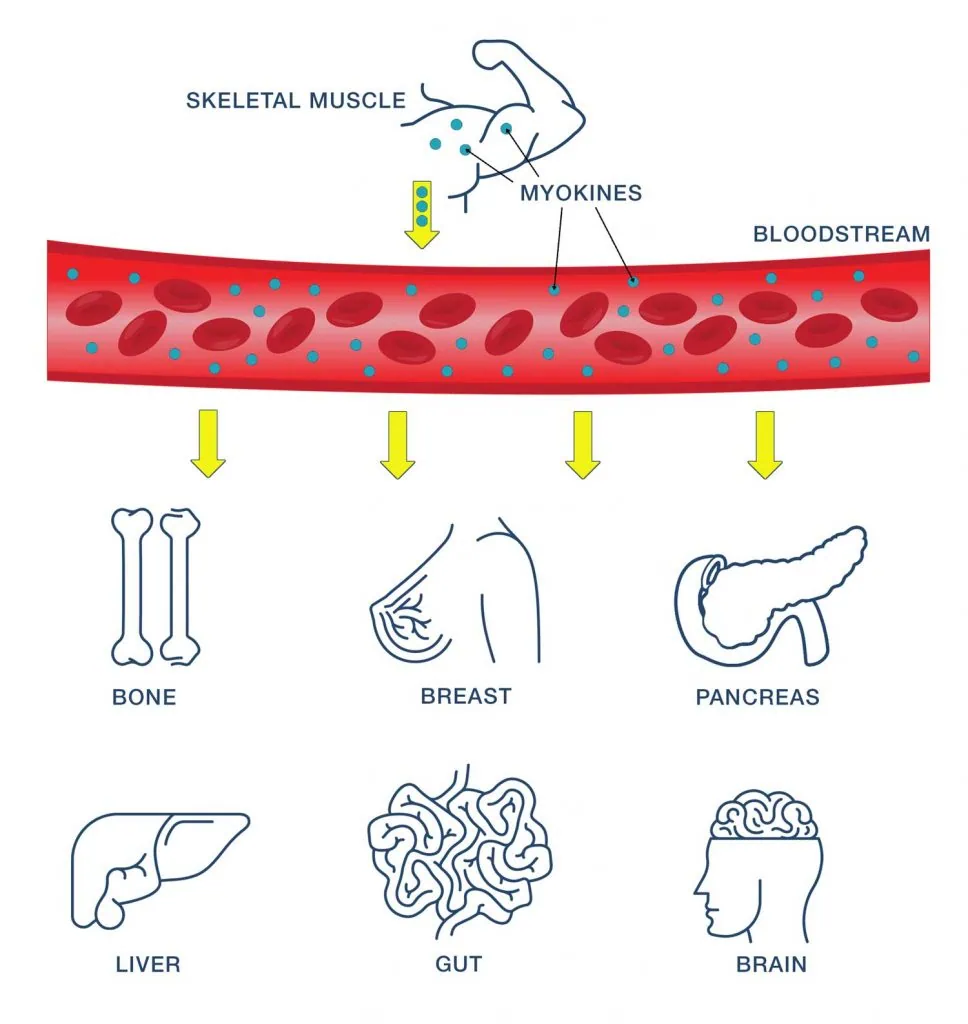
When it comes to measuring one of the most valuable substances in the body use the industry gold standard DEXA Scan.
SUBCUTANEOUS FAT
It is the layer of fat situated directly beneath the skin, providing insulation, cushioning, and energy storage. It is also what causes your body to jiggle and appear soft. This type of fat is visibly present in areas like the abdomen, thighs, hips, and buttocks, where it can be pinched or felt. Subcutaneous fat serves as a protective barrier against external temperatures and mechanical forces, helping to regulate body temperature and absorb shocks or impacts.
Measuring subcutaneous fat is crucial in securing the right exercise the nutrition program and prevents wasted time, money and energy. If your follow up DEXA Scan shows subcutaneous fat decreasing you know you your fitness program is working, if it doesn’t you know it’s not and can begin making adjustments.

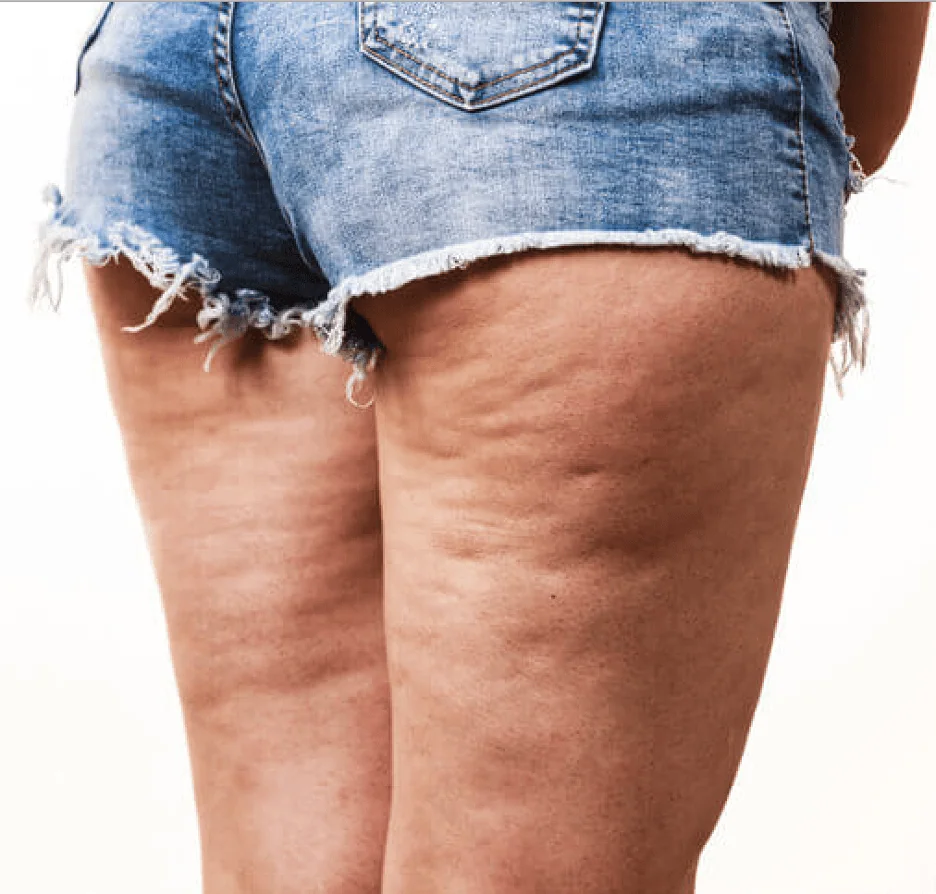
One of the biggest advantages of the DEXA measure body composition versus other methods is that every section of the body is measured and compared independently. If you want to focus on reducing fat in your abdomen, around your thighs or butt you can see to the gram the results from your program. The DEXA gives you the detailed accurate information to make real time fitness and decisions to target unwanted fat in the specific places of your body you want to remove. Ensure your time energy and efforts toward your fitness are maximized and not wasted by using the world’s golf standard in measuring subcutaneous fat.
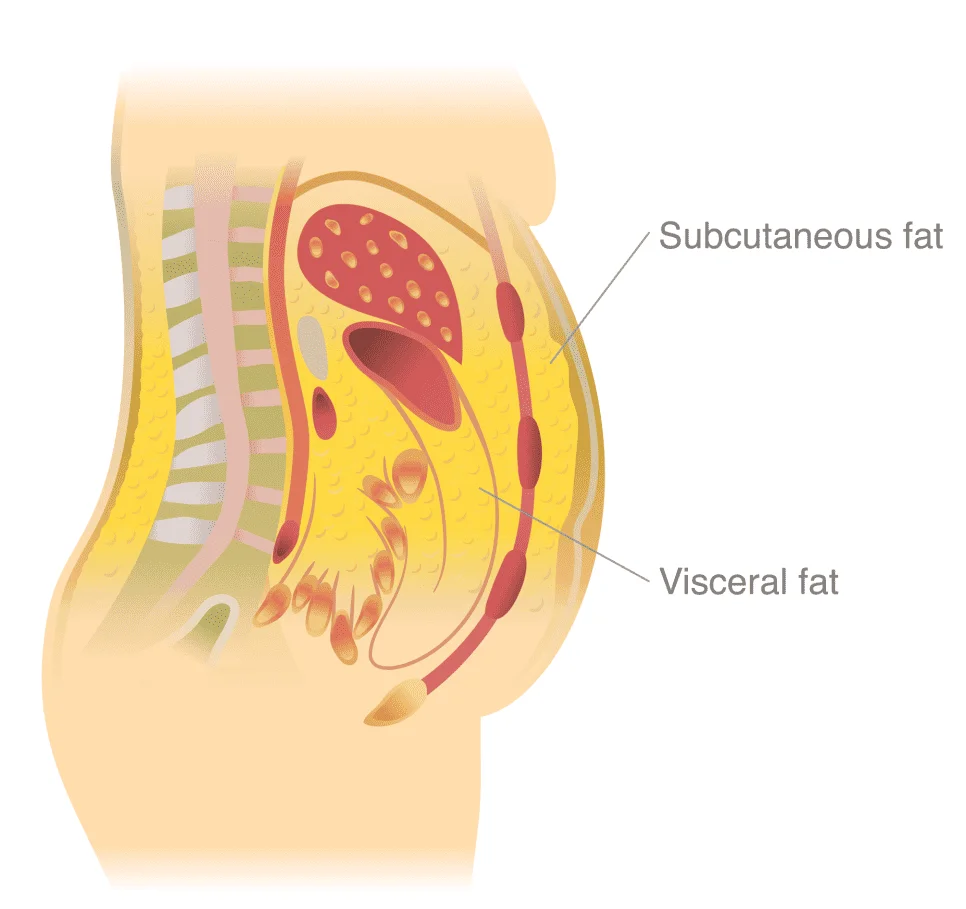
VISCERAL FAT
Visceral fat is a type of body fat that wraps around your abdominal organs deep inside your body. Some people describe visceral fat as giving a someone an ‘apple-shaped’ body rather than “pear-shaped” body. Since visceral fat is stored within the abdominal cavity, you can’t always see or feel it. You’ll also see visceral fat abbreviated as VAT, which stands for visceral adipose tissue.
Visceral fat is found near several vital organs, including:
- Stomach
- Liver
- Intestines
VAT makes up roughly 10% of your total body fat. Typically, women, elderly, and overweight people have a higher percentage of visceral fat.
However, the amount and distribution can vary depending on your age, sex, genotype, ethnicity, diet, physical activity, hormone levels, and even medications you may be taking.
Why is visceral fat dangerous?
If you have an abnormally high increase of visceral fat, this is also known as visceral obesity.
So how does excess fat affect the body’s organs? Excess body fat puts strain on the organs and bones and impairs the body’s responsiveness to insulin. As a result, this raises blood sugar and insulin levels.

This can lead to many serious health problems, including:
- Metabolic syndrome
- Cardiovascular disease and heart disease
- Impaired glucose and lipid metabolism
- Insulin resistance
- Increase risk of prostate, breast, and colorectal cancer
- Arterial hypertension and Hypertriglyceridemia
Do you want to assess your risk level of these medical conditions based on body fat percentages and estimations? If so, then you should schedule a Dexa scan
DEXA FOR BONE HEALTH
Prevent future fractures and monitor your skeletal health with an Apex Fit bone density scan
What’s your risk?

Osteoporosis is a silent bone hallowing disease affecting 52 million Americans. Discover your risk with DEXA bone density test.
- Learn if you have weak bones or osteoporosis before a fracture occurs
- Predict your chance of breaking or fracturing a bone in the future
- See if your bone density is improving, staying the same, or getting worse
- Find out how well your osteoporosis medicine is working
Your bone density test results are reported using T-scores. A T-score shows how much your bone density is higher or lower than the bone density of a healthy 30-year old adult. A healthcare provider looks at the lowest T-score to diagnosis osteoporosis.
What Your T-score Means. According to the World Health Organization (WHO):
- A T-score of -1.0 or above is normal bone density
- A T-score between -1.0 and -2.5 means you have low bone density or osteopenia
- A T-score of -2.5 or below is a diagnosis of osteoporosis

When it comes to measuring one of the most valuable substances in the body use the industry gold standard DEXA Scan.
Why Dexa?

Common alternative methods, such as BMI, Bioimpedance, and hydrostatic weighing, are often used incorrectly as a surrogate for body composition health. But they can be dangerously misleading.
For example, if you have a BMI of 25 kg/m2, you may have a body fat percentage anywhere from 10-35 percent. If you use other alternative methods, you may see a margin of error range from 5 to 15%.
Whereas as a DEXA scan’s accuracy and precision ranges from a 1 to 2 percent margin of error, it also provides additional information that BMI and alternative testing methods cannot, including:
- Visceral Adipose Tissue (VAT), which is leading predictor of longevity, metabolic syndrome, and cardiovascular disease
- Skeletal strength, your risk for osteoporosis, and how you compare to others like you
- Muscle symmetry to identify how your lean, fat, and bone mass compares in each region of your body
- “Skinny fat” and sarcopenia risks, which has been found to be an important predictor of cognitive performance
DEXA SCAN RESULTS
What You'll Learn and How to Proceed
After the Dexa Scan, your test results will return data on your percentage of visceral fat, weak points within the body, warning signs of possible health issues and diseases, and more. You’ll be able to access the data yourself on the Apex Fit mobile app.
The information from your results might be overwhelming at first, but it offers you a comprehensive look at where your body is health-wise.
The results of your Dexa Scan are meant to help you know how much exercise you need, the type of diet you should start, the best ways to build muscle mass, and how to pull your body into the best shape of your life.

In short, the Dexa Scan has the power to improve your life. This scan offers a simple way to tremendously alter how you view your health and wellness, while also giving you the tools to change how you approach fitness and diet.
The scan also helps you to work closely with your doctor about potential issues with your body. By pinpointing and determining problem areas, you and your doctor can make plans prevent and handle any health issues that come your way.
Furthermore, the Dexa Scan prep is easy to follow and makes for a fast appointment.
Get started today
Get the data you need for optimal health and fitness. Schedule your Apex Fit DEXA Scan today to get more out of your efforts.
Schedule Consultation
Frequently Asked Questions
A DEXA scan, which stands for Dual-Energy X-ray Absorptiometry, is a medical imaging technique used to measure bone mineral density (BMD) and body composition.
DEXA scans are commonly used to diagnose osteoporosis, assess fracture risk, monitor bone health, and evaluate body composition, including fat and lean mass.
During a DEXA scan, the patient lies flat on a table while a machine passes low-dose X-ray beams through the body. The amount of X-ray absorption by the bones and tissues is measured to determine bone density and body composition.
Yes, DEXA scans are considered safe, as they use very low levels of radiation. The amount of radiation exposure from a DEXA scan is minimal, similar to that of a standard chest X-ray.
Generally, there are no significant risks or side effects associated with DEXA scans. However, pregnant women should avoid DEXA scans due to the potential risk to the fetus from radiation exposure.
The DXA Scan itself is brief, taking between 7-12 minutes to completely and accurately test your body composition. Positioning can take a minute or two longer depending on your body type.
There’s usually minimal preparation required for a DEXA scan. Patients may be asked to refrain from taking calcium supplements before the scan, as they can interfere with the accuracy of the bone density measurement.
No, you shouldn’t feel anything during the DEXA scan itself. It’s a painless procedure that doesn’t involve any needles or injections.
DEXA scans are commonly recommended for postmenopausal women, individuals with risk factors for osteoporosis, those with a history of fractures, and anyone undergoing treatment that may affect bone health.
In most cases, the results of a DEXA scan are available shortly after the scan is completed. Your healthcare provider will discuss the findings with you and may recommend further evaluation or treatment if necessary.